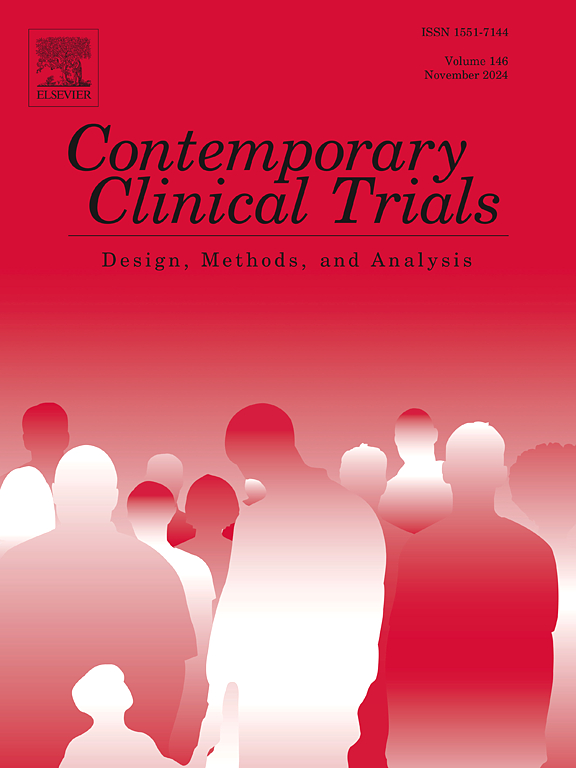Choice architecture in cascade genetic testing (CHARGE study) for hereditary cancer: Design of a hybrid type I randomized feasibility trial
IF 1.9
3区 医学
Q3 MEDICINE, RESEARCH & EXPERIMENTAL
引用次数: 0
Abstract
Background
Although cascade testing affords disease-free relatives the opportunity for genetically targeted primary disease prevention and is endorsed by multiple guidelines, utilization studies reveal that rates remain low. Lack of family communication and high testing costs are two of the most commonly documented barriers to testing. We leverage two well-known choice-architecture tools from psychology and behavioral science – default effect and zero price effect – to address these barriers and improve cascade testing rates in hereditary cancer. By altering the underlying choice architecture, individual decision-making can be influenced with minimal effort to support behavioral changes.
Methods/Design
This two-arm, single site, hybrid type I effectiveness-implementation randomized trial compares the effectiveness of a choice-architecture based cascade testing intervention versus usual care control among English-speaking patients with a pathogenic variant in a cancer susceptibility gene receiving care at a tertiary cancer center. The intervention includes proband-mediated recruitment of at-risk relatives, provision of genetic counseling, educational information about cascade genetic testing and free testing window, and return of results. The usual care arm follows standard of care for cascade genetic testing. The primary study outcome is cascade genetic testing rate measured by proband self-report. The study evaluates implementation process via survey, administrative, and interview data including acceptability, feasibility, and process outcomes.
Discussion
This trial will generate findings about the effectiveness of a cascade testing intervention targeting patients with a pathogenic variant in a cancer susceptibility gene and identify barriers and facilitators that influence implementing this intervention in clinical cancer genetic settings (ClinicalTrials.gov Identifier: NCT06284330).
遗传性癌症级联基因检测(CHARGE研究)的选择架构:混合I型随机可行性试验的设计。
背景:虽然级联检测为无病亲属提供了基因靶向原发性疾病预防的机会,并得到了多个指南的认可,但研究表明,使用率仍然很低。缺乏家庭沟通和高昂的测试费用是两个最常见的测试障碍。我们利用心理学和行为科学中两个著名的选择架构工具——默认效应和零价格效应——来解决这些障碍,提高遗传性癌症的级联检测率。通过改变潜在的选择架构,个人决策可以以最小的努力来支持行为改变。方法/设计:这项双组、单站点、混合型I型有效性实施随机试验比较了在三级癌症中心接受治疗的英语患者中,基于选择结构的级联测试干预与常规护理对照的有效性。干预措施包括先证者介导的高危亲属招募、提供遗传咨询、关于级联基因检测和免费检测窗口的教育信息以及返回结果。常规护理组遵循级联基因检测的标准护理。主要研究结果为先证者自述级联基因检测率。该研究通过调查、管理和访谈数据评估实施过程,包括可接受性、可行性和过程结果。讨论:该试验将发现针对癌症易感基因致病变异患者的级联检测干预的有效性,并确定影响在临床癌症遗传环境中实施该干预的障碍和促进因素(ClinicalTrials.gov标识符:NCT06284330)。
本文章由计算机程序翻译,如有差异,请以英文原文为准。
求助全文
约1分钟内获得全文
求助全文
来源期刊
CiteScore
3.70
自引率
4.50%
发文量
281
审稿时长
44 days
期刊介绍:
Contemporary Clinical Trials is an international peer reviewed journal that publishes manuscripts pertaining to all aspects of clinical trials, including, but not limited to, design, conduct, analysis, regulation and ethics. Manuscripts submitted should appeal to a readership drawn from disciplines including medicine, biostatistics, epidemiology, computer science, management science, behavioural science, pharmaceutical science, and bioethics. Full-length papers and short communications not exceeding 1,500 words, as well as systemic reviews of clinical trials and methodologies will be published. Perspectives/commentaries on current issues and the impact of clinical trials on the practice of medicine and health policy are also welcome.

 求助内容:
求助内容: 应助结果提醒方式:
应助结果提醒方式:


